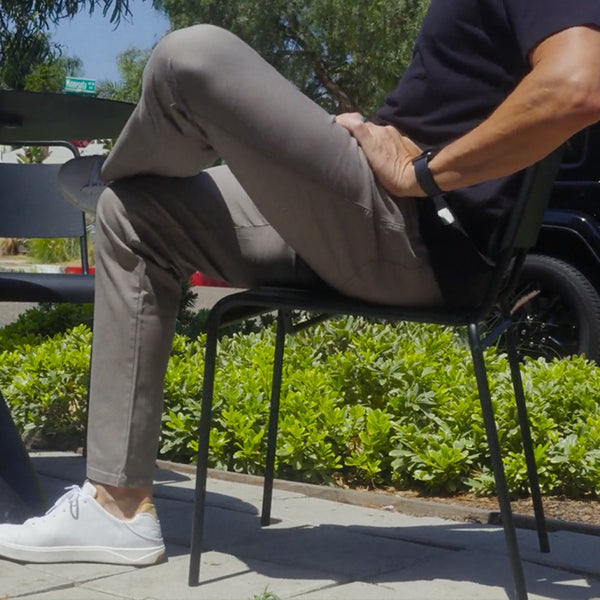Illustration: Ian Gilley
Ian Gilley is an artist in every sense of the word. His love for golf and acute knack for architecture inspired the Chicago-born creator to construct some of the most unique fantasy golf course designs. In fact, we loved them so much that we made a collaborative t-shirt and boardshort with him. We recently caught up with Ian in order to meet the man and philosophy behind the creative designs.
 Linksoul x Ian Gilley collab
Linksoul x Ian Gilley collabAs things work these days, we found you on Instagram. Who are you, anyway?
I’m 27, grew up in Chicago, finished high school and college in Orlando, and have lived near Washington D.C. for the past six years working on Capitol Hill. I played competitive golf for most of my life, until burning out during the spring of 2010. It was during the end of that summer and into the winter when I moved to Scotland for a semester and rediscovered the true aspects about golf that I love: travel, architecture, and the spirit of friendship that only this game can deliver.
The architectural patterns you post from your sketchbook remind us of how we used to draw the perfect wave on our notebooks as kids here in San Diego... Where are these courses and what drives you to make these?
When I was about 12 years old, I was sitting with my uncle at dinner after an afternoon of golf when he started to draw the front nine of Augusta National on the paper placemat with a golf pencil. I was struck by his ability to recall the features of each hole. It was just beautiful to watch a series of gentle curves turn into a bird’s-eye view of a course. My interest was immediate, and he challenged me to draw my own course right then and there. And the habit stuck. From that point on, as a form of meditation I have drawn thousands of fictional golf courses just for fun. They are entirely made up, and it has been amazing to see how my design sense has matured and expanded with each passing year. I typically draw them as a form of escape, trying to relax after a busy day or during a stressful time. And if I had to put a label on the inspiration for my preferred aesthetic, it would fall somewhere between Charles Blair Macdonald and Coore and Crenshaw with wide fairways, angular greens, multiple tee-to-green routes, and many blowout style bunkers.
What is golf in your world?
Golf, to me, is exploration. From finding that hidden gem to finding a working swing, it is human nature to chase the new, better, and unexpected with boy-like abandon. From hunting for that next great adventure with your pals to sweeping the dew and chasing sunsets, being in nature, enjoying a challenge—knowing that perfection is a fleeting endeavor, fusing history and integrity with the future and innovation—to me, that is golf.
What is the Sugarloaf Social Club?
Sugarloaf Social Club is a small group of friends dedicated to economic, architectural, environmental, and socially sustainable golf initiatives. We were worried that—after a few years of living, playing, and talking—golf and the camaraderie would fail to continue after college. So, after having a day at the nearby Coore and Crenshaw course during our last week of classes at Sugarloaf Mountain, NLE, we formed our official group sealed with a scotch game and a few handshakes as a way to keep the fire alive. As SSC has grown, we have been able to expand our circle to over a dozen chaps from around the country, with the goal of promoting what we think the best of golf should and could be. Our most visible presence may be on Instagram, but what a lot of folks don’t see are the hours, days, weeks, and months devoted to talking and consulting with creative brands, superintendents, golf course architects, and fellow tastemakers, offering our thoughts on how to make golf a more exciting, interesting, and endurable landscape. My favorite aspect of Sugarloaf is our ability to find beauty in everything, by highlighting something that might be overlooked or overshadowed. This is what fuels us. Of course, we care about playing the world’s greatest courses—those often are associated with greatest architecture our game has to offer—but we are, by no means, list-checkers or status-chasers. Many times, we would take the burnt-out, shaggy muni over the pristine and proper golf factory with fancy accolades. Give us a hole in the ground and a few clubs and we will be happy as clams. And that is why when something has our approval, you can trust that it is going to be interesting, cool, or significant and not just because some magazine, the media, or any amount of money told us so.
What’s your vision for golf?
My vision for golf is a more egalitarian industry across the board, wherein a paradigm would have been shifted, managing the public’s taste for bouncier courses with reasonable conditioning. I think the game suffers from the so-called Augusta and US Open syndromes that have conditioned us to think greener and harder equates to better. Being responsible about water usage, promoting tree management programs, and encouraging the use of more local and natural plants and materials is how we can lower the cost barrier to golf, allowing people to enjoy a game—not as a rare treat, but as a common activity of everyday life. In America, Mike Keiser has showed us how modern architecture can begin to influence this shift. And now it’s up to us as the next generation to continue to devise ways to make golf more enjoyable, accessible, and affordable—be it by bigger fairways, shorter rough, slower greens, alternative designs, and, for example, par-three, executive short loops. Also, by supporting more junior golf programs, reducing resource inputs, and educating the public.
So, on these dream courses that you see in your head, who is in your foursome?
Definitely, my dad. He introduced me to this game and afforded me the boundless experiences so that I could ultimately find out for myself what was special about golf for me. Next, would be my uncle. Without him I would have never caught the golf, travel, architecture, and history bug. Rounding out the crew would have to be my grandpa. He had Alzheimer’s when I was a boy and passed away due to a heart attack while playing a round of golf. Because of his condition late in life I have had to learn about him mostly from older family members and their incredible stories. It would be amazing to share just one final round with him on a course that I dreamt of.
What’s your perfect day made of?
My perfect day would be during mid-summer in Culver, Indiana at my family’s lake cottage. I would rise extra early with the waterskiers, when the water is pure glass. I would head the other way across the street to the local nine-hole: Langford and Moreau. After a peaceful and dew-swept loop, I would return home for coffee and buttered toast on the porch before heading out on the boat to catch the start of the sailboat races. Then, after crushing a quick nap, my friends and family would get an afternoon 18-hole game going at the austere Pete Dye track, Mystic Hills, across town. Coming home to cook burgers, the young night would be finished off with a conversation-swept sunset cruise, followed by burning a little midnight oil over some tasty scotch, only to do it all over again the next day.
See more from Ian on Sugarloaf Social Club's Instagram.









Leave a comment (all fields required)